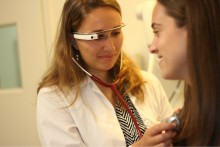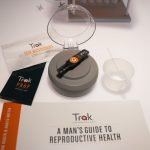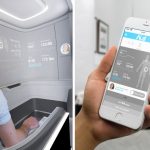Augmedix Plans To Expand Google Glass-Based System For Healthcare

A year ago, a flurry of news stories declared the failure of Google’s Web-connected eyewear Google Glass after the company halted sales of the novel item whose debut it had trumpeted in 2012. Critics said consumers could never figure out a compelling use for the $ 1,500 smart glasses, which are equipped with a video camera, microphone, and clear see-through lenses that can display data for the wearer. And others worried about privacy.
But surgeons and other medical professionals had been quick to see potential in the hands-free, voice activated glasses. Many trials were launched in clinical practice, though doctors saw a need for improvements in security and other factors. Startups such as San Francisco-based digital health startup Augmedix got to work, and the company is now trying to establish a mass market for Google Glass in the healthcare industry.
Augmedix, which adapted Google Glass to help doctors take notes as they examine patients, is earning revenues from hundreds of physicians who subscribe to the company’s service, CEO Ian Shakil says. The company has just announced a $ 17 million fundraising round to finance the expansion of its system to more hospitals, clinics, and doctors.
Redmile Group led the fundraising round, joined by existing investors Emergence Capital and DCM Ventures. Also among the backers were five large healthcare systems that Shakil says are Augmedix customers. They include San Francisco-based Dignity Health; Sacramento, CA-based Sutter Health; Englewood, CO-based Catholic Health Initiatives (CHI); and Cincinnati, OH-based TriHealth Inc. The fifth system is remaining incognito for now.
Augmedix, founded in 2012 by Shakil, now counts users in almost all U.S. states. Every day, the company says, about 5,000 patients see a doctor who wears a Google Glass device that operates with Augmedix software. The system was designed to relieve physicians of a time-consuming task that comes with the era of electronic health records—entering data in computers while they talk to patients.
Instead of interrupting the conversation to tap away at a laptop, the doctor uses Google Glass to communicate with an observer who is invisible in the examination room—a remote human “scribe” who listens in and records the exam notes. The scribe—a “trained medical professional” working in a distant, secure location—can also provide information from the patient’s health records during the exam. In response to the doctor’s spoken question, data such as results of the patient’s last cholesterol test appear on the Google Glass transparent display screen.
Augmedix touts the system as a way to “rehumanize the doctor-patient relationship” because the clinician can have a more natural conversation without looking away to make notes.
But will patients feel comfortable in the exam room under the gaze of a video camera, while an unknown person is seeing and hearing what the doctor does? It was a question Augmedix had to answer, Shakil says.
“When we first founded the business, we were quite uneasy about patients’ reactions to Google Glass,” Shakil says. But that didn’t turn out to be an obstacle, he says. Data security was also a concern within the medical profession when the smart glasses were first proposed for clinical use.
Wireless communication between the Google Glass device and Augmedix’s Web-based servers is encrypted, the company says. Its scribes work in “cockpits” at facilities that comply with HIPAA’s patient privacy regulations, Shakil says. They can’t bring smart phones, cameras, or other electronics into the workspace. Most of the Augmedix scribes work in India and Bangladesh, where they earn middle class salaries for those regions, he says. The scribes fill in the exam record, which the doctor then checks and approves.
The scribes are trained to coordinate with each doctor’s way of working. Shakil says the scribes fill in only medically relevant data, but they may include information that comes up in the discussion if the doctor likes to remember “a bit about the patient’s life.”
Shakil acknowledges that the scribes are exposed to information that identifies patients, such as their ID numbers and facts mentioned during the exams. Augmedix technology can’t block that 100 percent, he says, but the company takes steps to protect patient privacy.
“We hire great people, and we nurture a culture of great respect for healthcare information. We are a training heavy company,” Shakil says. He points out that many other workers have access to electronic health records, including front desk staffers, nurses, billers, and coders.
Patients who feel spooked by having their doctor wired up to an unseen third party while they discuss their health issues can opt out of the technology-enhanced exams, Shakil says.
“Google Glass can come off, no questions asked,” Shakil says. Fewer than 2 percent of patients nationwide have refused permission for their doctors to use the technology, he says.
So far, Augmedix users are primary care physicians and orthopedic surgeons rather than doctors in fields such as gynecology and proctology, where the discussion may revolve around more sensitive personal matters, Shakil says. “Perhaps that’s why our acceptance rate is so good.”
Augmedix charges a monthly fee for each doctor using the service, which includes the smart glasses. The company doesn’t disclose its revenues, but Shakil says the monthly fee is in “the low-single-digit-thousands of dollars.” Augmedix, which has 500 employees, has now raised a total of $ 40 million.
One of its early competitors in the medical field, Austin, TX-based Pristine, had been developing healthcare applications for Google Glass and other smart glasses. The startup raised $ 5.4 million in late 2014. But it may have changed its focus, the Austin Business Journal reported. It is now marketing its smart glass-based system called EyeSight to insurance companies and other businesses that want to inspect far-flung properties or products without sending out their top experts. A field worker or junior technician can wear the glasses on-site, while providing video and other data to the company expert, Pristine says. Pristine could not be reached for comment.
(32)













